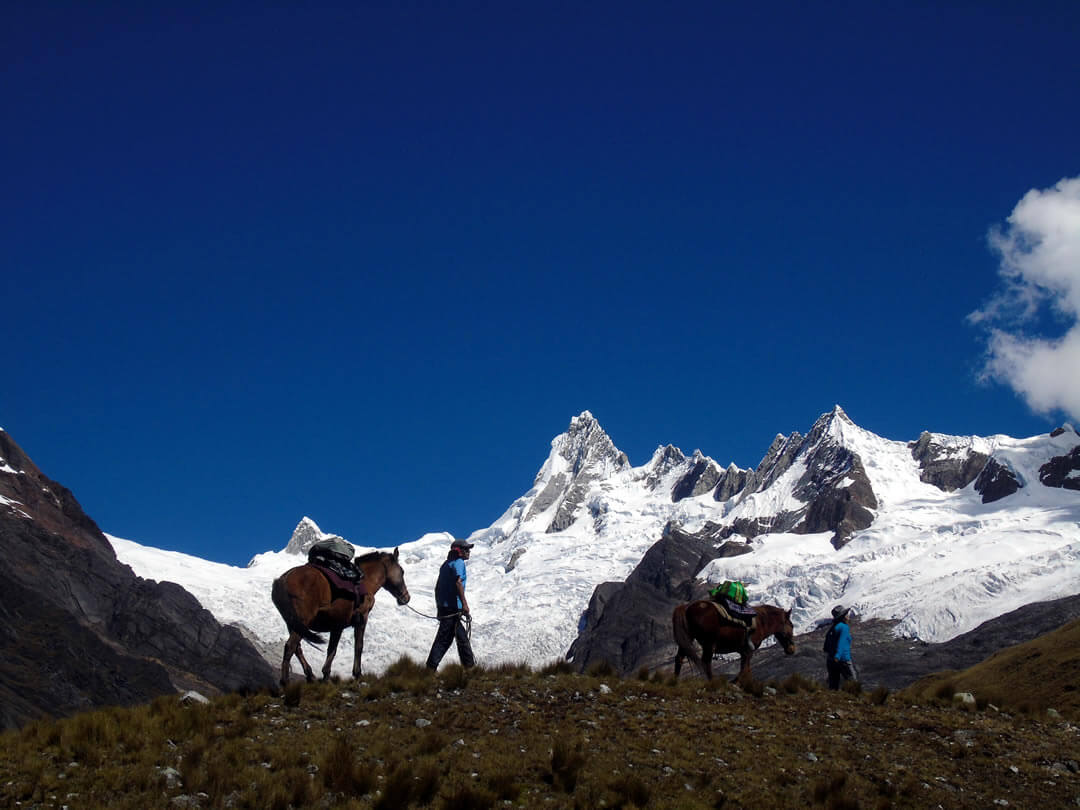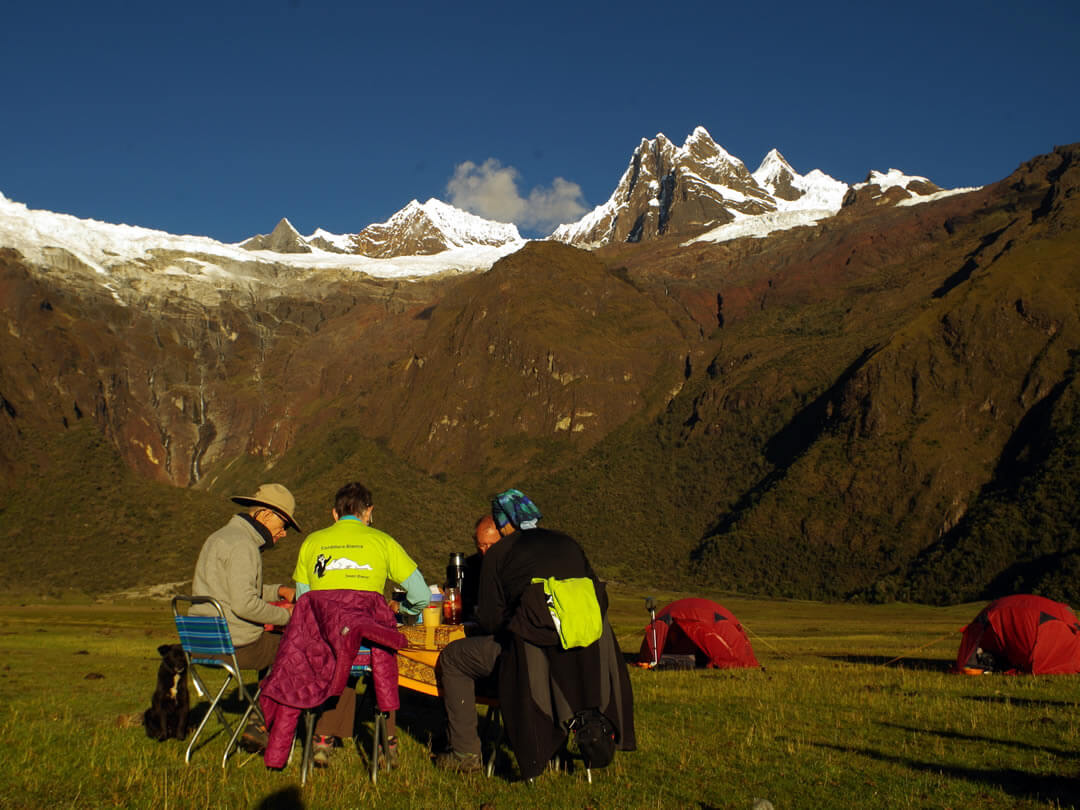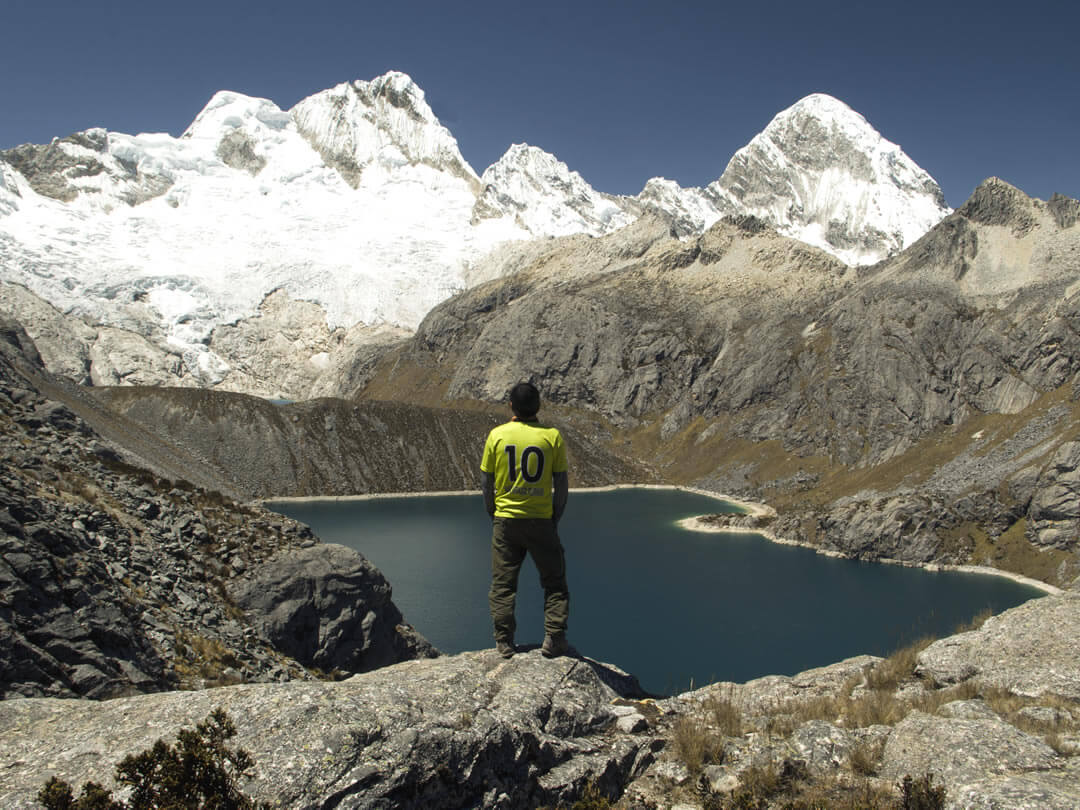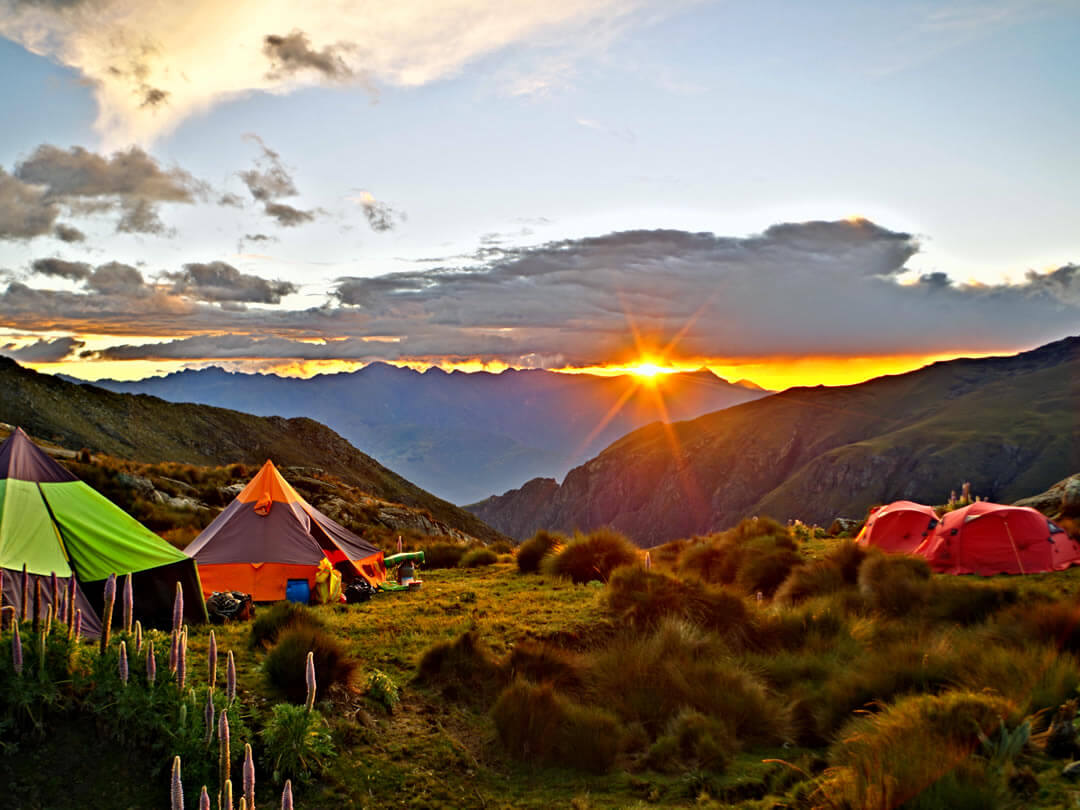TRIP OVERVIEW
TOUR INFORMATION
ITINERARY
WATCH VIDEO
GALLERY
MAP
TRIP OVERVIEW
This is one of the longest and most important treks in the Peruvian Andes. The route covers a large section of the northern Cordillera Blanca with campsites above 3700 meters and passes over 4700 meters. The trails pass very close to glaciated peaks and we’ll have the opportunity for a close-up view of important mountains such as Huascaran, Chacraraju, Taulliraju, and Alpamayo, the last of these was given the title of “the most beautiful mountain in the world” by the German magazine Alpinisimus in 1966. We will also see multicolored glacial lakes and rivers cutting through deep Andean valleys as well as the flora and fauna native to this, the highest tropical mountain range in the world.
Duration of trip: 16 days / 15 nights.
Departures dates 2024
Upon request
Places visited:
- The Huaraz city
- The Cordillera Blanca
- The Huascaran National park
- Rock forest of Hatun Machay
- Alpamayo mountain
TOUR INFORMATION
Trip includes:
- Six nights in a hotel
- Transfers from/to airport and bus stations
- All food during the trek and as indicated on the itinerary when we are in town
- Bus tickets (Lima – Huaraz – Lima) with a first-class agency
- Transportation to and from the trek
- Two acclimtazation hikes in the Huaraz vecinity
- A bilingual (English/Spanish) guide for the trek
- Camp cook
- Burro driver
- Pack animals (burros and/or horses)
- Emergency horse
- General camping equipment for everyone’s use
- Entrance fees to the park and tourist sites
- First aid kit
- General logistics for the trip
Trip does not include:
- Food or meals not specifially mentioned above
- Travel or accident insurance
- Visas or Immunizations
Acclimatization
As you can see on the itinerary, the trek includes two days of acclimatization hikes in the vicinity of Huaraz, because the trek takes place in regions higher than 3000 meters.
Hotels
These are the hotels we will be staying in on this tour: Hotel Bay View in Lima and Hotel Morales in Huaraz, both of 3 star category. In the event that there is no availability, we will change for other of the same category.
Equipment list
- WA backpack with a capacity of 60 or 70 liters (this could be a duffle or other similar bag of comparable size)
- A daypack
- A sleeping bag (we recommend that it be lightweight, synthetic or down, compressible, and warm to temperatures that may drop below 12°C.
- A warm down or synthetic jacket
- Three pairs of trekking pants (cotton pants such as jeans are not advisable because they will not dry when they get wet)
- Two to four pairs of wool socks
- T-shirts, long sleeve shirts, a sun hat, and a wool knit cap
- A light rain jacket or rain poncho and a pair of rain pants
A good pair of trekking boots in good condition - A light pair of shoes or sandals for camp
- A pocketknife
- A headlamp with spare batteries
- A pair of sunglasses (VERY IMPORTANT)
- A tube of sunscreen and lip balm with sunscreen (VERY IMPORTANT)
- Any medicines you need
- Personal and hygienic items
- A set of light or medium weight long underwear tops and bottoms
- A pair of gaiters
- A pair of gloves
Optional
- Trekking poles
- Personal sleeping pad
- Camera
- Book, notebook, and pen
Climate
The trekking season in the Cordillera Blanca and Huayhuash extends from April to September. Even though this is technically winter in the southern hemisphere, this is also the dry season with very little rain in these months as we are close to the equator. In the dry season the weather is very stable; we can expect only a couple of days with precipitation each week. The average temperature in the mountains above 4000 meters from April to September is between 10 and 14°C. At night the temperature may drop below freezing.
Is this trip appropriate for me?
Anyone who joins a trek like this must be prepared to live with only the basics. You’ll be sleeping in a tent with a sleeping bag and without access to showers. You’ll need to be reasonably physically fit, in good health, and able to adapt to the high altitude environment. For people who have a health concern that could affect their ability to perform on the trek, it is recommendable that they discuss this with their doctor.
ITINERARY
Day 1: Arrival in Lima
Airport pickup and transfer to hotel.
In the hotel meeting with the group, welcome words from one member of the staff of Go2Andes and tour briefing.
Meals included: none
Day 2: Lima – Huaraz
At the appointed time you will be picked up at your hotel and taken to the bus terminal. You will travel to Huaraz leaving at 9:30 a.m. and arriving at about 5:30 p.m. You will then be picked up at the bus station and taken to your hotel.
Meals included: breakfast
Day 3: The Rock Forest of Hatun Machay
At about 8:00 a.m., after having breakfast, we board our vehicle and head south from the city of Huaraz following the shores of the Santa River for about two hours to Hatun Machay, which can be translated as “Big Cave”. Located at 4200m, this geological formation features a large overhang in which there are exceptional ancient rock paintings and many curious rock outcrops, which resemble various animals including a gorilla, a peccary, an eagle, and a snail to name just a few. Hatun Machay is also a popular rock climbing destination with many bolted routes and an excellent vantage point for views of the Cordillera Huayhuash.
Meals included: breakfast | lunch
Day 4: Lake Churup
After breakfast, at the appointed hour (about 8:00 a.m.), we will leave Huaraz (3100m) in a private vehicle and head east toward Pitec, which is situated on the border of Huascaran National Park. Here we will begin to climb to Lake Churup (4450m), which takes about two and a half hours. After a rest and ample time to take photos we will return via the same route to Huaraz, arriving at about 4:00 p.m.
Meals included: breakfast | lunch
Day 5: Huaraz – Llanganuco – Portachuelo Pass – Vaqueria – Paria
You will be picked up at your hotel after breakfast and driven in a northward direction from the city of Huaraz down the Huaylas Valley to Yungay, a town lying directly below the mountain Huascaran. From here, we follow an unpaved road that will take us all the way to a small village called Vaqueria (3700m). Along the route we’ll make stops at Lake Llanganuco and Portachuelo Pass (4670m). From the pass we will have a panoramic view of some of the most important peaks of the Cordillera Blanca such as: Huascarán, Huandoy, Pisco, Chacraraju and Tocllaraju. From Huaraz, it’s about a four-hour drive to Vaqueria, where our burro driver and his pack animals will be waiting. From here we begin our trek, which involves walking some three hours in the Huaripampa Valley to our campsite in a spot called Paria at an altitude of 3800 meters.
Meals included: breakfast | lunch | dinner
Day 6: Paria – Punta Unión Pass– Tuctu
At the appointed time we’ll depart from camp and begin the climb to Punta Unión Pass. It’s a hike of about three and a half hours. The pass is in a position very close to the precipitous peak Taulliraju and has stupendous views of the Santa Cruz and Huaripampa valleys. After a break to rest and take photos, we’ll turn around and descend by the same route to a trail that veers off towards Tuctu (4200m). It’s about two and a half hours walking from the pass to this campsite.
Meals included: breakfast | lunch | dinner
Day 7: Tuctu – Alto Puka Hirka Pass– Huecrococha
Today we head in the direction of Alto Puka Hirka Pass, which is at an altitude of 4725 meters. It will take about two and a half hours of hiking to get there. From this point we can see the summits of Taulliraju, Paria, Chacraraju, and others. We then begin to descend and walk a route that follows the shore of Lake Huecrococha (3800m). Our campsite is located at the end of the lake.
Meals included: breakfast | lunch | dinner
Day 8: Huecrococha – Tupa Tupa Pass– Jankapampa
Like the previous days, we will begin to walk after breakfast, this time heading towards Tupa Tupa Pass (4400m). After descending we will climb back uphill again and reach the pass after about about two and a half hours. We then contour along the mountainside and later descend into the Jankapampa Valley. In about three and a half hours walking from the pass we will arrive at our camp under the Pucahirka peaks, which is at an altitude of 3700 meters.
Meals included: breakfast | lunch | dinner
Day 9: Jankapampa – Yanajanka Pass – Willka
We’ll spend the first part of today hiking about three hours to Yanajanka Pass, which has an altitude of 4600 meters. From here we will have time to admire views of the Yanajanka and Yanta Quenua Valleys. To continue to our next stop we will head down the Yanta Quenua Valley, which is three more hours walking from the pass to the campsite in Willka (4200m).
Meals included: breakfast | lunch | dinner
Day 10: Willka – Mesapata Pass – Kara Kara Pass– Jankarurish
At the appointed hour, after breakfast, we will continue on our adventure. Today we cross two passes. The first, Mesapata Pass, we will reach after two hours hiking. We’ll then do a small descent before we begin to climb again to the second pass and the second highest point of our trek, Kara Kara Pass (4830m). This is a trip of three and a half hours from the Mesapata Pass. From here we descend another hour and a half to the Alpamayo Valley. We will camp in a place called Jankarurish (4200m), close to the mountain Alpamayo.
Meals included: breakfast | lunch | dinner
Day 11: Jankarurish, Alpamayo Viewpoint
Today our destination is the Alpamayo overview (4500m), which is located above Lake Jankarurish. From here we have a close-up view of the most “beautiful mountain in the world”, a title bestowed upon the Alpamayo in a German photography competition in 1974. After a break to rest and take photos we will return by the same trail to our campsite where our cook will have a special traditional lunch waiting for us. The whole outing for this day will take about five hours.
Meals included: breakfast | lunch | dinner
Day 12: Jancarurish – Los Cedros Pass – Osoruri
As on previous days, we’ll begin our walk at the appointed time. It starts with a short descent down the Alpamayo Valley followed by a climb up to Ventuna Pass (4770m). We’ll reach the pass after about four hours walking. Here we can enjoy views of the mountains Milwacocha, Pilanco, Pumapampa, and others. From the pass we descend a further one and a half hours to a spot called Osoruri were we will make our camp for the night.
Meals included: breakfast | lunch | dinner
Day 13: Osoruri – Llampapashillun – Wishkash
At the appointed hour, we’ll leave our campsite and head in the direction of Llampapashillun (4850m). This pass marks the highest point on our trek and is a four-hour climb from camp. From the pass we descend to Lake Cullicucocha, a sky-blue wonder sitting at the foot of the Santa Cruz peaks. After an appropriate rest we’ll continue to our next campsite, Wilka (4350m). Located on the west side of the Cordillera Blanca, Wilka affords a vast view of the Huaylas Valley and the Santa River.
Meals included: breakfast | lunch | dinner
Day 14: Wishkash – Huaylcayan – Huaraz
We will spend this, the last day of our trek descending a series of switchbacks with views of the Callejón de Huaylas, which is an enormous Andean valley many of whose streams and rivers issue from glacial melt in the Cordillera Blanca. After four hours we will arrive in a village called Hualcayan (3250m). Our vehicle will there be waiting for us to begin the three-hour drive back to Huaraz.
Meals included: breakfast | lunch
Day 15: Huaraz – Lima
At the appointed hour you will be picked up at your hotel in Huaraz and brought to the bus terminal where you will board the 11:00 a.m. bus for Lima. Upon arrival in Lima at about 7:00 p.m., you will be met by a vehicle, which will take you to your hotel.
Meals included: breakfast
Day 16: Lima – Point of departure
At the appointed time, you will be picked up at your hotel and dropped off at the airport.
Meals included: breakfast













